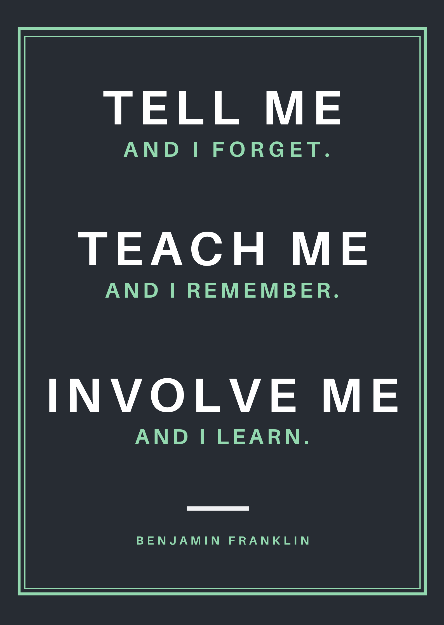
Personal learning styles affect the learning outcomes for participants. By default, these affects the ratings and reviews participants give to the online course.
This article assists online educators and curriculum developers on how to use a participant’s learning style to their advantage when creating online courses and what sort of concepts should be use to create the course content.
It all comes down to the golden rule of course creation – know your audience (learners or participants).
1. Learning Styles
Research shows that each learning style uses different parts of the brain. By involving more of the brain during learning, we remember more of what we learn. Researchers using brain-imaging technologies have been able to find out the key areas of the brain responsible for each learning style.
For example:
- Visual: The occipital lobes at the back of the brain manage the visual sense. Both the occipital and parietal lobes manage spatial orientation.
- Aural: The temporal lobes handle aural content. The right temporal lobe is especially important for music.
- Verbal: The temporal and frontal lobes, especially two specialized areas called Broca’s and Wernicke’s areas (in the left hemisphere of these two lobes).
- Physical: The cerebellum and the motor cortex (at the back of the frontal lobe) handle much of our physical movement.
- Logical: The parietal lobes, especially the left side, drive our logical thinking.
- Social: The frontal and temporal lobes handle much of our social activities. The limbic system (not shown apart from the hippocampus) also influences both the social and solitary styles. The limbic system has a lot to do with emotions, moods and aggression.
- Solitary: The frontal and parietal lobes, and the limbic system, are also active with this style.
There are seven types of learning styles as follows:
- Visual (spatial) - Learn best with images.
- Aural (auditory-musical) - Learn best with sound.
- Verbal (linguistic) - Learn best using words, both in speech and writing.
- Physical (kinesthetic) - Learn best by doing.
- Logical (mathematical) - Learn best with logic and reason.
- Social (interpersonal) - Learn best with others.
- Solitary (intrapersonal) - Learn best alone.

2. How to engage the seven types of learners?
Because learners have different learning styles or a combination of styles, online educators and curriculum developers should design activities that address multiple modes of learning in order to improve the likelihood of successful experiences for each learner.
-
Physical (kinesthetic)
Course design principles:
- Kinesthetic learners learn best through experience or performing tasks.
- Mobile learning opportunities are becoming much more prominent, which allow the kinesthetic learner to learn on-the-go while not tied down to a specific schedule.
- Try to have learners make, create or do something physical. Anything physical or hands on will help. Demonstrate how to do something physical.
- Incorporate 3D graphics in the course presentation to replicate the physical world.
- Simulations with 3-Dimensional graphics can replicate physical demonstrations.
- Take actions in the educator and instructor videos. Give assignments that encourage observation and learn by doing.
- Hands-on labs.
- Incorporate interactive elements in course materials
- Mind mapping activities and assignments.
- Create assignments that have real-life connection.
- Branching scenarios can help real world applications and simulate higher stakes that will engage kinesthetic learners.
- Keep lectures short and novel
- Kinesthetic learners find it difficult to sit still for long periods of time. They struggle with staying focused on the same thing for long periods of time. Long lectures with static content can be challenging for kinesthetic learners. To remedy this difficulty, keep lectures short, or break up long lectures into multiple parts.
- Course facilitation principles for kinesthetic learners. Challenge learners to incorporate simple tactile exercises into the studying.
- Help learners to visualize complex processes
- If an assignment or instructional material contains a complex procedure, encourage learners to visualize themselves doing the procedure to help them associate physical motions with the information. Consider providing a screencast that allows them to watch and follow along on their screens if they want to.
- Encourage exploration and experimentation
- Kinesthetic learners learn best by doing rather than by reading or listening, hence, allow them to experiment and figure out a new assignment or assessment themselves rather than dictating them how to do it. Let them explore resources on their own terms and assemble the information in a way that makes sense to them so they can exercise critical thinking and hands on in their learning.
- Assign activities in which learners have to go out into the real world to complete assignments and then report their findings and reactions to their peers in a forum. Interactive or engaging tasks will help the kinesthetic learner reach their maximum potential and have the highest level of success in their learning endeavours.
-
Visual (spatial)
Course design principles:
- Use powerpoint or screen casting.
- Include bullet points on slides and useful checklists and articles for download.
- Include visuals such as images, graphs/charts and imagery such as cartoons related to the subject matter.
- Diagrams, mind maps, flowcharts, drawing out concepts, processes will aid visual learners.
- Incorporate Youtube videos.
-
Aural (auditory-musical)
Course design principles:
- Recording lectures and lessons for listening and reference.
- Include stories and anecdotes, music, references to podcasts and interviews.
- Repeating important points help.
- Even a song or jingle to convey a lesson point is helpful to learners with this learning style.
-
Verbal (linguistic)
Course design principles:
- Note taking exercises such as assignments that require writing.
- Written test
- Quiz.
- Transcripts.
- Research topics.
- Handouts for reading.
- Self-assessment.
-
Logical (mathematical)
Course design principles:
- Games, quizzes and activities.
- Activities and assignments need to be highly structured rather than open ended.
- Incorporate statistics/data/facts in the topic and explain how these relate to each other very clearly.
-
Social (interpersonal)
Course design principles:
- Discussion boards.
- Group projects.
- Engage social learners by responding to their questions and messages in a reciprocal way.
- Refer learners to forums and other social groups.
- Request learners to follow with instructor on Twitter and other social media.
- Include some language in teaching style that refer learners as a group rather than a single person.
-
Solitary (intrapersonal)
Course design principles:
- Learners are independent learners and more introverted.
- Learner prefers to learn on their own.
- People with a solitary learning style like to make plans and set goals. Incorporate goal setting and structured paths to achieve learning objectives into the course design.
- Solitary learners like to think. So, do not rush course subject matter and move through topics too quickly.
- Self-reflection through journaling.
- Offer opportunities to journal or keep a log and provide a lot of optional background or history on the topic for introverted thinkers to go explore and think.
3. Grouping the Learning Styles
Because learners have different learning styles or a combination of styles, online educators and curriculum developers should design activities that address multiple modes of learning in order to improve the likelihood of successful experiences for each learner.
Do not get overwhelmed at the thought of creating materials for each seven types of learners – seven different versions.
Online educators and curriculum developers can group them into tendencies and features to help the creation of the course content a bit easier.
Group 1 – Visual and Physical
These two types of learners are grouped together because visual learners learn best by seeing and physical learners do best by being shown what to do and then doing it themselves.
Group 2 – Aural
Aural learners are very straightforward and can be provided for easily.
Group 3 – Verbal and Logical
These two types of learners are grouped together because online educators and curriculum developers can create written materials that address problems and solutions logically.
This article was contributed by Emeritus Professor Gary Goh, who is an Author, Educator and Entrepreneur.


